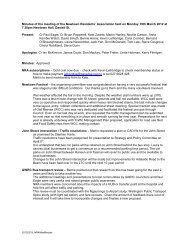Draft Town Belt Management Plan - Wellington City Council
Draft Town Belt Management Plan - Wellington City Council
Draft Town Belt Management Plan - Wellington City Council
You also want an ePaper? Increase the reach of your titles
YUMPU automatically turns print PDFs into web optimized ePapers that Google loves.
1 Introduction<br />
The horseshoe shaped <strong>Town</strong> <strong>Belt</strong> seen from Te Ahumairangi Hill Lookout<br />
<strong>Wellington</strong> has a very beautiful natural setting by world standards. The inner city faces north and<br />
east to the natural sweep of Lambton Harbour, and steep hills enclose it from behind. The inner<br />
suburbs cling to these hills of which large areas, including significant ridgetops, are <strong>Town</strong> <strong>Belt</strong>.<br />
1.1 The <strong>Town</strong> <strong>Belt</strong> concept<br />
<strong>Wellington</strong> is fortunate to retain a large portion of the space set aside as <strong>Town</strong> <strong>Belt</strong> in 1839 under<br />
the instruction of the Secretary of the New Zealand Company, John Ward, who stated:<br />
“It is indeed desirable that the whole outside of the <strong>Town</strong>, inland, should be separated from the<br />
country by a broad belt of land which you will declare that the Company intends to be public<br />
property on condition that no buildings be ever erected upon it."<br />
Originally held by Central Government (the Crown) after it was gazetted in 1841, this horseshoeshaped<br />
green space on the hills cradling the central city and inner suburbs has been administered<br />
and controlled by <strong>Wellington</strong> <strong>City</strong> <strong>Council</strong> since 1873.<br />
A <strong>Town</strong> <strong>Belt</strong> is an area of land set aside during the design of towns and cities to provide a green and<br />
open space for the pleasure and health of the citizens. This design approach had been advocated by<br />
utopian and radical social reformers in Britain since the early 19th century as a means of providing<br />
relief for ordinary citizens from the overcrowding of the cities.<br />
Today it is widely accepted that open space in the city is essential to not only the character and<br />
function of the city but the physical, emotional and spiritual health and wellbeing of its people.<br />
Cities around the world with environmental and social problems are working to improve the urban<br />
environment, and the provision of open space is high on the agenda. Once the built landscape is<br />
there, trying to retrofit the cityscape to include open space is incredibly difficult and often<br />
impossible. Established open space within the urban landscape, (especially a large, diverse,<br />
connected, accessible and visible open space network like the <strong>Town</strong> <strong>Belt</strong>), is extremely valuable to<br />
the city and the people who live there.<br />
Contemporary ideas on the value of natural environments fit with the <strong>Town</strong> <strong>Belt</strong> concept. The<br />
<strong>Town</strong> <strong>Belt</strong> in <strong>Wellington</strong> protects a large, predominantly natural, open-space environment with a<br />
<strong>Draft</strong> <strong>Town</strong> <strong>Belt</strong> <strong>Management</strong> <strong>Plan</strong> October 2012 1





